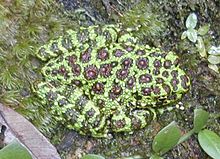tr
kırıntılardaki isimler


True frogs is the common name for the frog family Ranidae. They have the widest distribution of any frog family. They are abundant throughout most of the world, occurring on all continents except Antarctica. The true frogs are present in North America, northern South America, Europe, Africa (including Madagascar), and Asia. The Asian range extends across the East Indies to New Guinea and a single species, the Australian wood frog (Hylarana daemelii), has spread into the far north of Australia.
Typically, true frogs are smooth and moist-skinned, with large, powerful legs and extensively webbed feet. The true frogs vary greatly in size, ranging from small—such as the wood frog (Lithobates sylvatica)—to large.
Many of the true frogs are aquatic or live close to water. Most species lay their eggs in the water and go through a tadpole stage. However, as in most families of frogs, there is large variation of habitat within the family. There are also arboreal species of true frogs, and the family includes some of the very few amphibians that can live in brackish water.[1]
The Ranidae are related to several other frog families that have Eurasian and Indian origins, including Rhacophoridae, Dicroglossidae, Nyctibatrachidae, Micrixalidae, and Ranixalidae. They are thought to be most closely related to the Indian-endemic Nyctibatrachidae, from which they diverged in the early Eocene. However, other studies recover a closer relationship with the Dicroglossidae.[2][3]
It was previously thought that the Ranidae and their closest relatives were of Gondwanan origins, having evolved on Insular India during the Cretaceous. They were then entirely restricted to the Indian subcontinent until the late Eocene, when India collided with Asia, allowing the Ranidae to colonize Eurasia and eventually the rest of the world.[3] However, more recent studies instead propose that the Ranidae originated in Eurasia, and their close relationship with India-endemic frog lineages is due to those lineages colonizing India from Eurasia during the Paleogene.[2][4]
The subdivisions of the Ranidae are still a matter of dispute, although most are coming to an agreement. Several former subfamilies are now recognised as separate families (Petropedetidae, Cacosterninae, Mantellidae, and Dicroglossidae). The genus Rana has now been split up and is much reduced in size.
While too little of the vast diversity of true frogs has been subject to recent studies to say something definite, as of mid-2008, studies are going on, and several lineages are recognizable.[5][6][7]
The following phylogeny of some genera was recovered by Che et al., 2007 using mitochondrial genes.[9]
Sylvirana (1)
Sylvirana (2)
Sylvirana (3)
Sylvirana (4)

Most of the subfamilies formerly included under Ranidae are now treated as separate families, leaving only Raninae remaining. The following genera are recognised in the family Ranidae:
A number of taxa are placed in Ranidae incertae sedis, that is, their taxonomic status is too uncertain to allow more specific placement.
True frogs is the common name for the frog family Ranidae. They have the widest distribution of any frog family. They are abundant throughout most of the world, occurring on all continents except Antarctica. The true frogs are present in North America, northern South America, Europe, Africa (including Madagascar), and Asia. The Asian range extends across the East Indies to New Guinea and a single species, the Australian wood frog (Hylarana daemelii), has spread into the far north of Australia.
Typically, true frogs are smooth and moist-skinned, with large, powerful legs and extensively webbed feet. The true frogs vary greatly in size, ranging from small—such as the wood frog (Lithobates sylvatica)—to large.
Many of the true frogs are aquatic or live close to water. Most species lay their eggs in the water and go through a tadpole stage. However, as in most families of frogs, there is large variation of habitat within the family. There are also arboreal species of true frogs, and the family includes some of the very few amphibians that can live in brackish water.